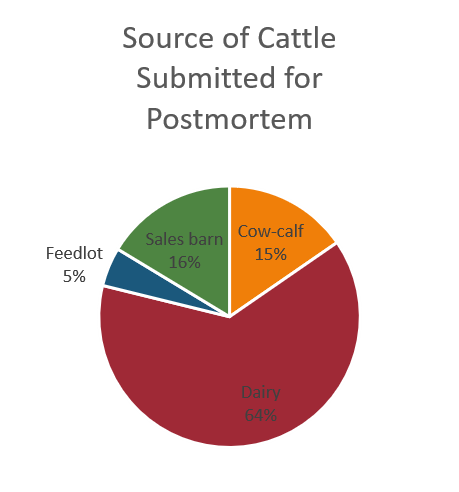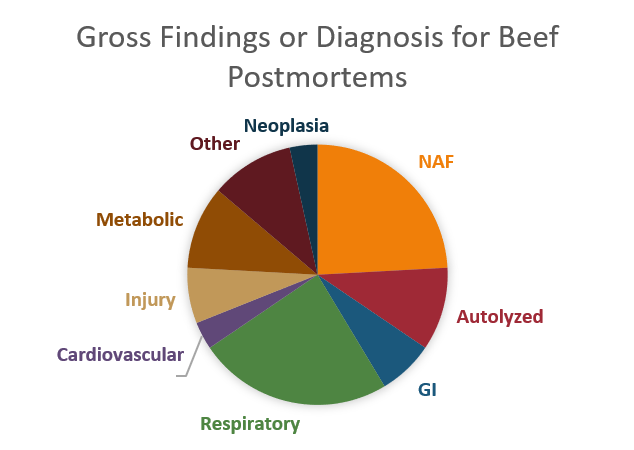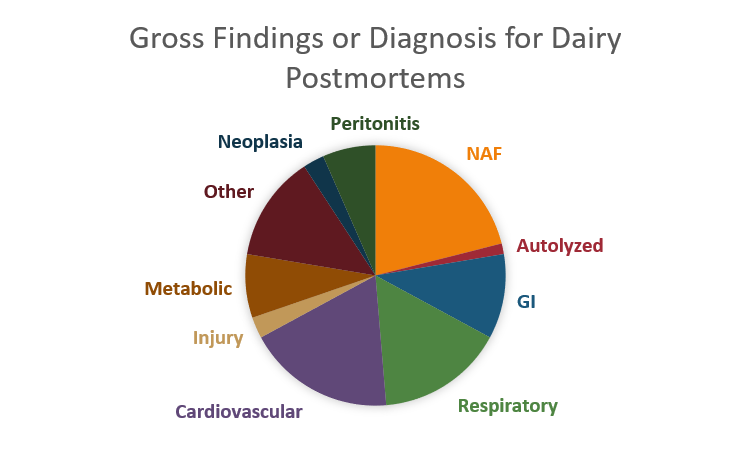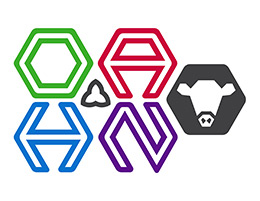Ontario Animal Health Network (OAHN) Bovine Expert Network Quarterly Producer Report
OAHN Q3 Laboratory Data from the Animal Health Laboratory
There were 126 bovine pathology submissions between August 1 and October 31, 2020.
Salmonella Dublin abortion in a dairy cow
A near-term aborted Holstein fetus presented to the AHL from a dairy herd in which there was a history of two previous abortions in the last 2 months. The farm also had losses from respiratory disease in young calves. Salmonella Dublin was diagnosed as the cause of abortion and septicemia among calves. This is the first abortion due to Salmonella Dublin reported in Ontario. More details on the case can be found in the AHL December newsletter at https://www.uoguelph.ca/ahl/abortion-and-calf-septicemia-associated-salmonella-dublin-infection-holstein-herd
In total, Salmonella Dublin was isolated on bacterial culture from 9 submissions representing an estimated 7 unique premises this quarter. S.Dublin was the primary etiology associated with septicemia diagnoses in Q3.
Respiratory disease
Pneumonia was the most frequent pathology diagnoses among cattle between the ages of 2 mo and 2 years and cattle over 2 years of age. Pneumonia etiologies detected in mature cattle this quarter were Pasteurella multocida, Trueperella pyogenes, Mannheimia haemolytica, and Helococcus sp.
Abortion
There were 27 submissions for abortion investigations (dairy n=22, beef n=2, commodity unreported n=3). The infectious causes of abortion identified were bacterial (n=10, including Trueperella pyogenes, Salmonella Give, Salmonella Bovismorbicans, Salmonella Dublin, Streptococcus sp., and E. coli), Leptospirosis (n=2), Neospora (n=1), BVD (n=1), and mycotic (n=1).
Bovine Viral Diarrhea Virus
A total of 131 submissions included BVD tests (not including serology) and a total of 373 BVD PCR tests were conducted in Q3 . There were 16 positive PCR tests representing 3 different premises. Positive detections were from ear notch screening and one abortion in a dairy cow.
Project Summary Report: Surveillance of postmortem data from a livestock disposal site
 Postmortems are a valuable tool for diagnosis and prevention of disease in food animals. Depending on goals, timing, transport options, and costs, veterinarians might perform postmortems on-farm or submit for postmortem at a diagnostic laboratory. Summaries of pathology data for the Ontario Animal Health Network indicate that mature cattle are under-represented among cattle postmortem submissions at the provincial diagnostic laboratory. Within Ontario, cattle postmortems are routinely performed by local veterinarians at a centralized livestock disposal unit when circumstances preclude on-farm postmortem and it is requested by producers, other veterinarians, or livestock sales barns. These necropsies represent animals within approximately a two-hour driving radius around the livestock disposal site. The objectives of the project were to summarize postmortem data available from the veterinarians conducting postmortems at a livestock disposal site, and to provide the OAHN bovine network with additional data diagnosed by gross post-mortem at a livestock disposal site to data already being collected at the Animal Health Laboratory.
Postmortems are a valuable tool for diagnosis and prevention of disease in food animals. Depending on goals, timing, transport options, and costs, veterinarians might perform postmortems on-farm or submit for postmortem at a diagnostic laboratory. Summaries of pathology data for the Ontario Animal Health Network indicate that mature cattle are under-represented among cattle postmortem submissions at the provincial diagnostic laboratory. Within Ontario, cattle postmortems are routinely performed by local veterinarians at a centralized livestock disposal unit when circumstances preclude on-farm postmortem and it is requested by producers, other veterinarians, or livestock sales barns. These necropsies represent animals within approximately a two-hour driving radius around the livestock disposal site. The objectives of the project were to summarize postmortem data available from the veterinarians conducting postmortems at a livestock disposal site, and to provide the OAHN bovine network with additional data diagnosed by gross post-mortem at a livestock disposal site to data already being collected at the Animal Health Laboratory.
Two veterinarians performing the postmortems at the disposal site agreed to enter the data from postmortems conducted into a central registry for the project for a one-year period. For each postmortem, the veterinarians collected the type of animal (dairy or beef), source (dairy, cow-calf, feedlot, sales barn), source county if available, breed, age, history prompting investigation, and gross postmortem findings/diagnosis if available. A total of 105 bovine postmortems (76 dairy and 29 beef) were conducted between June 2019 and July 2020 by the local veterinary practice. Submissions came from 20 different counties; 16% were from sales barns and 84% direct from farms.


A variety of presenting complaints were included in the history but most frequently were sudden death (n=31), down or died in transport (n=18), down on-farm (n=15), and respiratory disease (n=13). By system category, the most frequent findings were cardiovascular (18%), respiratory (16%), and gastrointestinal (11%) for dairy cattle. No abnormal findings were detected in 21% of cases. A smaller number of beef submissions limited analysis, but the most frequent systems affected were respiratory (24%) and metabolic (10%). Among beef submissions 24% had no abnormal findings and 10% were too extensively autolyzed for a proper postmortem to be carried out.
These results show that a variety of presentations prompt gross postmortem and a livestock disposal site can be an opportune location to pursue gross PM if it cannot be accomplished on farm. Time to arrival and progressing autolysis within the carcass limited the opportunity to thoroughly investigate the cause of death in some cases. Although not able to be directly compared, the OAHN bovine network noted general similarities between the types of bovine diagnostic lab pathology submissions and outcomes and those collected in the project, suggesting one source is not receiving unique submissions from the other.
OAHN Project: Disease testing in newly introduced cattle OPEN for submissions
The bovine OAHN project that provides a free panel of testing for newly or recently purchased dairy and beef cattle will be open until April. Eligible cattle are tested for Salmonella Dublin, Johne’s, Bovine Leukosis Virus, and Anaplasmosis. For a full description of the project and how to participate, check out the Q2 report at
https://www.oahn.ca/reports/oahn-bovine-producer-report-q2-2020/


